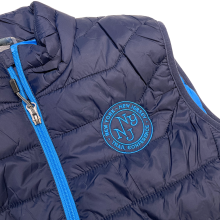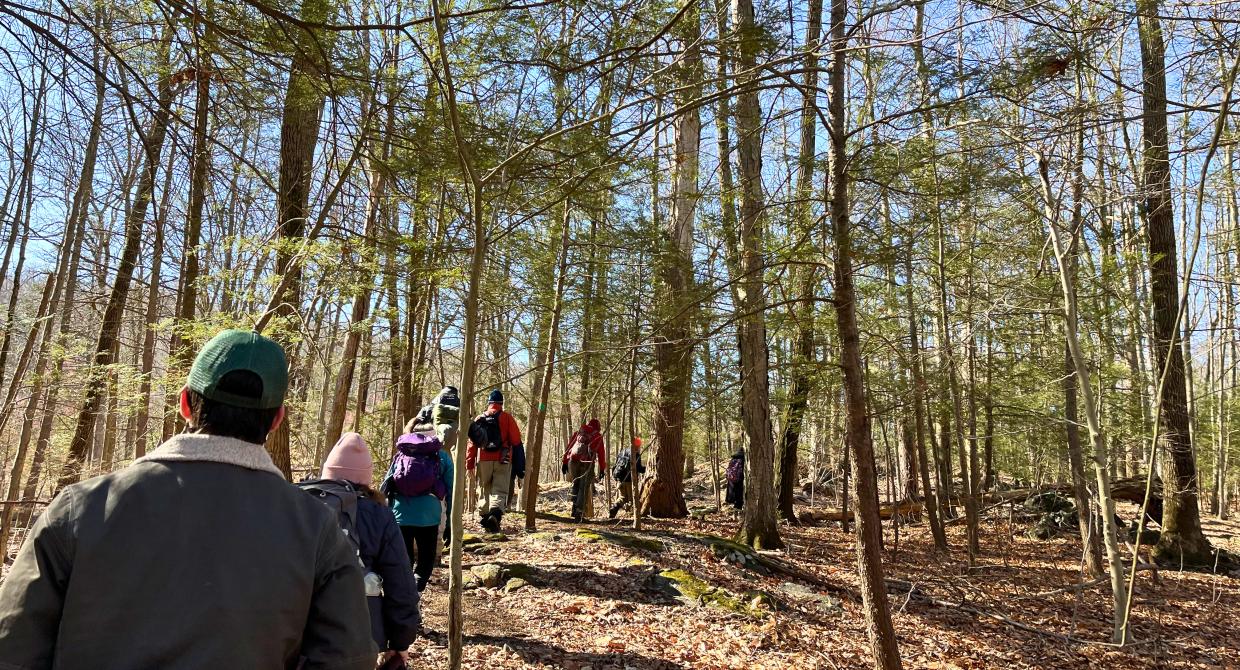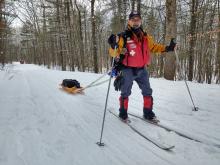
Spring Hiking Tips from a Search and Rescue Responder
Title

Body
Spring hiking can present challenges that require special preparation in both gear and mindset. It seems like the only thing that is constant is change, and that’s especially true of the seasons. As a member of New Jersey Search and Rescue (NJSAR), I need to be ready to deal with varying conditions year-round and usually at a moment’s notice. When it comes to hiking, the primary concern is your health and safety, followed by the enjoyment of the hike. As you read ahead, you’ll find that I’m a very strong believer in mindset being just as important as gear. If you’re new to hiking and gear preparation, I suggest reading The 10 Essentials of Hiking. Another important concern is the impact that your activities may have on the sensitive trail environment during this unpredictable time of year. More on that later.
Dress for nighttime.
Transitional seasons, like spring, can be more hazardous than winter. Hikers may be fooled by warm days and set out with minimal preparations. A lesson I learned while working for the Forest Service is to dress for nighttime, not daytime. Step outside the night before a hike and ask yourself, “Would I sit in these conditions for an extended period of time in a t-shirt and shorts, or in what I normally wear on a warm spring day?”
Here’s where mindset comes into play. I don’t even like to walk from a store parking lot in cold or wet conditions without proper protection! That’s because years of experience have helped form my mindset. When my pride whispers in my ear that I’ll be fine or that I can tough it out, my mind screams, “YOU CAN GET STUCK OUT THERE!” If you train yourself to suit up properly when a survival situation is unlikely, you will be less inclined to take chances when the risk is higher.
Bring extra insulation.
Spring is not the time to store away all your winter clothing and insulation. Hypothermia, a dangerous and sometimes fatal cooling of the body core, is not just a winter occurrence. Most cases occur between 30° and 50°F — that’s above freezing! If you add total immersion in water, that temperature rises. A cold, drenching rain without protection can be more dangerous than snow. Your goal in playing it safe should be to carry extra insulation and keep it dry. Some insulating materials, like wool, will insulate when wet, but keeping them dry is more desirable. Avoid wearing cotton clothing and getting down-filled insulation wet, as well.
Stay dry.
Moisture comes from two sources: the weather and your body. Your body’s moisture, or sweat, can be controlled by synthetic wicking base layers and venting. Carry an outer shell to cover both your upper and lower body, and don’t hesitate to put it on. A good rain suit with breathable material like Gore-Tex, as well as zippered venting holes, can do the job. Ponchos can also be very handy but begin to lose their effectiveness in windy conditions.
Sturdy waterproof boots sealed by gaiters are a good way to deal with excess moisture, and hiking staffs combined with good soles will help you with poor footing in mud and on slopes. Hiking staffs can also be used to test water and mud depths as well as firmness of footholds before stepping forward.
In a pinch, if you’re ever lost, injured, or caught in the dark (general four-season hiking tip: carry a light source. See: The 10 Essentials of Hiking), you could improvise by carrying and using a contractor-grade trash bag. All you need to do is make a hole for your face and invert it over you, and it will keep you dry and increase your warmth. You can also use a reflective emergency blanket or disposable poncho to achieve similar results.
Plan ahead.
There are times when many of us may still be caught unprepared, so factor this into your planning. Prepare for the worst-case scenario. If that forecasted 10% chance of rain finds you, it may as well be 100%. You need to be prepared to deal with it. Consider that seriously before you set out!
Bring extra food and fluids.
Other than clothing considerations, make sure to drink plenty of fluids and eat well. Carry some extra high-carb snacks, and be sure to bring water-based drinks, which are needed to convert those carbs to heat energy (eating dry energy foods without fluids will not be as effective — it might even increase dehydration). Drinking alcoholic beverages should be avoided at all costs.
Consider trail conditions.
Another aspect to consider when hiking in the spring is the local trail conditions where you plan to hike. Ice coatings can still be a concern. In my area of northwestern New Jersey, in recent memory, I’ve witnessed frozen precipitation into late April, and you can probably add a month or more to that in the Catskills and further north.
Traditionally, in the northeast, spring is known as “mud season.” Frozen ground in the winter is much more stable. As the temperature gets warmer, the upper layers soften first, but the lower frozen layers prevent drainage. Add that to melting snow and heavy rain, and it creates a muddy quagmire in flat places along the trail and poor footing on slopes. Also, streams that are dry in mid-summer tend to be swollen and often can’t be crossed at certain locations.
What happens as a result of these conditions is that hikers take detours, creating new trails and widening existing ones, which causes more incidents of erosion and vegetation damage. Staying in the center of the trail is crucial to minimizing these impacts. Detours in densely forested areas can also cause people to lose sight of the trail and get lost. As a Trail Conference volunteer Trail Maintainer, I aim to get my first inspection of my designated trail done as close to the beginning of spring as possible to spot these issues.
Pack a map.
Another approach is to consider taking a different route. Sometimes, extreme weather conditions cause serious trail damage that requires trail closures. Some closures are long term until repairs can be done, while others are short term until things dry out. It’s advisable to have a Trail Conference map, both in print and digital. In some areas, having a map allows you to make mid-hike adjustments to reroute around hazards and sensitive areas. All members of NJSAR are required to own certain Trail Conference map sets, and I recommend having them if you are hiking in the tri-state area. Shop Trail Conference maps.
By checking your mindset and prepping the right gear, you will be equipped to take spring hiking precautions very seriously. You may end up carrying a little extra weight in your pack, but don’t think it’s for nothing. That one-in-ten-chance when it’s needed will make it worth it. Luckily, we’ll never know for sure how many search and rescue missions are prevented due to good planning and preparations. Visit NJSAR’s website to learn more about the team: NJSAR.org. Now, get out there and enjoy the wonderful outdoors!
John Rovetto is a life member of New Jersey Search and Rescue, where he works on the Preventing Search and Rescue project to inform youth and parents how to avoid getting lost and what to do if it happens. He is also a senior Nordic backcountry patroller, a former Mountain Travel and Rescue advisor with the NJ Region of the National Ski Patrol, a Trail Conference volunteer Trail Maintainer and certified Chain Sawyer, and is a New York State Department of Environmental Conservation Licensed Guide. He leads many hikes at Stokes State Forest and High Point State Park, including National Trails Day and First Day hikes.


